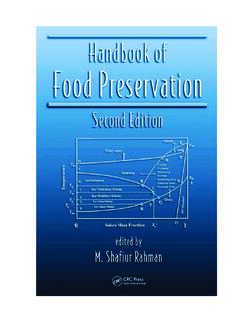Transcription of A table of food types and microorganisms of concern to ...
1 A table of food types and microorganisms of concern to food safety. FOOD PATHOGEN COMMENTS USUAL PRESERVATION SYSTEM Raw Poultry Campylobacter Salmonella Other pathogens could be present too. Raw poultry will have a high microbial load, however this will be reduced on cooking. Pathogenic species will be present in many samples, therefore raw poultry should be handled with scrupulous hygiene prior to cooking. Chilling reduces microbial growth rate. Vacuum / modified atmosphere packing can extend shelf life, but this increases risk of anaerobic pathogen growth ( Clostridium botulinum).
2 Raw Meat Campylobacter Salmonella Pathogenic E. coli Clostridium botulinum poses a risk in VP/MAP products Other pathogens could be present too. Raw meat will have a high initial microbial load, which will be reduced on cooking. Chilling reduces microbial growth rate. Vacuum / modified atmosphere packing can extend shelf life, but this increases risk of anaerobic pathogen growth ( Clostridium botulinum). Raw Fish and Shellfish Salmonella Vibrio parahaemolyticus/ cholerae Listeria monocytogenes Clostridium botulinum (MAP/VP) Histamine (Scombrotoxin) producers Planktonic toxins (PSP, DSP, ASP) Viruses Chemical and toxin poisoning is more relevant to cooked fish, the bacterial poisoning organisms are more applicable to ready to eat products.
3 Chilling reduces microbial growth rate. Vacuum / modified atmosphere packing can extend shelf life, but this increases risk of anaerobic pathogen growth ( Clostridium botulinum). Bakery products Bacillus cereus Clostridium botulinum (MAP/VP) Staphylococcus aureus Baking should reduce the numbers of microorganisms present in a dough / batter, however it will not be sufficient to kill all microbes. Baking will reduce the water activity and give a short, ambient shelf life. Baked products are sometimes packed in a modified atmosphere to further extend life, but this increases risk of anaerobic pathogen growth ( Clostridium botulinum).
4 Fruit and Fruit Juices Salmonella Listeria monocytogenes Pathogenic E. coli Mycotoxin The low pH of fruit generally prevents growth from pathogenic bacteria, however there have been reports of E. coli growth in apple products. It is also possible for pathogens to survive without increasing in number, and this is of particular concern in unpasteurised products. The low pH of these product types will extend shelf life in combination with chilled storage. Raw Vegetables / Salad / Sprouted seeds Salmonella Listeria monocytogenes Pathogenic E.
5 Coli Viruses Microbial counts of raw vegetables are likely to vary, and washing cannot be guaranteed to significantly reduce the load. The risk from pathogenic microbes is relatively low, but they must be regularly screened for in RTE products. Chilled storage will extend the shelf life. These products are sometimes packed in a modified atmosphere to further extend life, but this increases risk of anaerobic pathogen growth ( Clostridium botulinum). Dairy Products Salmonella Listeria monocytogenes Staphylococcus aureus Pathogenic E.
6 Coli Campylobacter Pasteurised products will have a lower pathogen risk than raw products. Live fermented products will have a high total count. Monitoring Enterobacteriaceae can be used as a hygiene indicator. Chilling extends the shelf life of dairy products, UHT will give a long ambient shelf life. Processed Foods (RTE or to be re-heated) Clostridium botulinum (MAP/VP chilled products) Salmonella Listeria monocytogenes C. perfringens Bacillus cereus Staphylococcus aureus V. parahaemolyticus Pathogenic E.
7 Coli This is a broad product grouping, therefore the organisms listed to the left will present greater or lesser concern dependent on product type. Fermented products will present a high LAB/TVC without detriment to the product. VP/MAP cooked meats can also have a high LAB count and remain unspoiled. The risk from C. botulinum applies to chilled MAP/VP products intended to be stored for longer than 10 days. Chilling is usually the method by which shelf life is extended for this product grouping. This will act in concert with other factors such as salt levels, preservatives and packaging atmosphere to give a unique, though short, shelf life.
8 This must be validated as being safe for each product. Dried foods to be cooked (rice/pasta, pulses/grains, herbs/spices, dried meat) Salmonella Pathogenic E. coli Staphylococcus aureus Organisms of concern are spore formers or are those able to survive at low water activities. If moulds are of concern , one should be aware of the possibility of mycotoxin Low water activity will limit the growth of microbes, therefore a long ambient shelf life is usually achievable. Bacillus cereus C. perfringens formation.
9 Cooking should eliminate vegetative pathogens, spore formers can survive to be an issue in stored product. Dried raw RTE foods (nuts, fruit, museli, herbs/spices) Salmonella Bacillus cereus C. perfringens Aflatoxin (nuts) Pathogens may be able to survive if hygiene during production is poor. TVC will be high in herbs and spices. If moulds are of concern , one should be aware of the possibility of mycotoxin formation. Generally no organisms will grow as the aw is too low, but pathogen presence must be considered, as must end use of the product.
10 Once rehydrated, growth of many contaminants could occur. Low water activity will limit the growth of microbes, therefore a long ambient shelf life is usually achievable. Dried heat-processed foods (breakfast cereals, crisps, confectionery, herbs/spices). Salmonella Bacterial spores could survive heat processes, however their growth should be limited by low Aw. Salmonella poisoning has been linked to breakfast cereals, probably due to a post-process contamination. microorganisms can tend to survive for long periods in these low aw products.


